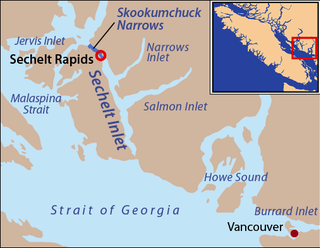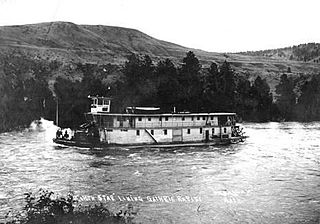Chinook Jargon is a language originating as a pidgin trade language in the Pacific Northwest. It spread during the 19th century from the lower Columbia River, first to other areas in modern Oregon and Washington, then to British Columbia and parts of Alaska, Northern California, Idaho and Montana. It sometimes took on the characteristics of a creole language. The contact language Chinook Jargon should not be confused with the Indigenous language Chinook.

The Yakama are a Native American tribe with nearly 10,851 members, based primarily in eastern Washington state.

The Skookumchuck River is a 45-mile (72 km) long river located in southwest Washington, United States. It is a tributary of the Chehalis River, which is the largest drainage basin located entirely within the state.

The Clatsop are a Chinookan-speaking Indigenous people of the Pacific Northwest of the United States. In the early 19th century they inhabited an area of the northwestern coast of present-day Oregon from the mouth of the Columbia River south to Tillamook Head, Oregon. Today, Clatsop descendants are members of the federally recognized Confederated Tribes of Siletz Indians, as well as the unrecognized Chinook Indian Nation and Clatsop-Nehalem Confederated Tribes.

Skookumchuck Narrows is a strait forming the entrance of Sechelt Inlet on British Columbia's Sunshine Coast in Canada. Before broadening into Sechelt Inlet, all of its tidal flow together with that of Salmon Inlet and Narrows Inlet must pass through Sechelt Rapids. At peak flows, standing waves, whitecaps, and whirlpools form at the rapids even in calm weather. The narrows are also the site of Skookumchuck Narrows Provincial Park.

The Chinook salmon is the largest and most valuable species of Pacific salmon. Its common name is derived from the Chinookan peoples. Other vernacular names for the species include king salmon, Quinnat salmon, Tsumen, spring salmon, chrome hog, Blackmouth, and Tyee salmon. The scientific species name is based on the Russian common name chavycha (чавыча).
The Haisla language,, is a First Nations Wakashan language spoken by the Haisla people of the North Coast region of the Canadian province of British Columbia, who are based in the village of Kitamaat.

Keish, also known as James Mason and by the nickname Skookum Jim Mason, was a member of the Tagish First Nation in what became the Yukon Territory of Canada. He was born near Bennett Lake, on what is now the Yukon–British Columbia border. He lived in Caribou Crossing, now Carcross, Yukon.

Sechelt Inlet formerly Seechelt Inlet is one of the principal inlets of the British Columbia Coast. The inlet is significant in that it almost makes an island of what is instead the Sechelt Peninsula, whose isthmus is at the town of Sechelt at the head of the inlet. The isthmus is less than 1.2 km (0.75 mi) in length. Sechelt Inlet's mouth is at Jervis Inlet, inland from the Malaspina Strait.
Skookumchuck is a Chinook Jargon term that is in common use in British Columbia English and occurs in Pacific Northwest English. Skookum means "strong" or "powerful", and "chuck" means water, so skookumchuck means "rapids" or "whitewater", or fresh, healthy water. It can mean any rapids, but in coastal usage refers to the powerful tidal rapids at the mouths of most of the major coastal inlets.
Pacific Northwest English is a variety of North American English spoken in the U.S. states of Washington and Oregon, sometimes also including Idaho. Due to the internal diversity within Pacific Northwest English, current studies remain inconclusive about whether it is best regarded as a dialect of its own, separate from Western American English or even California English and/or influenced by Canadian English with which it shares its major phonological features. The dialect region contains a highly diverse and mobile population, which is reflected in the historical and continuing development of the variety.
A Dictionary of Canadianisms on Historical Principles (DCHP) is a historical usage dictionary of words, expressions, or meanings which are native to Canada or which are distinctively characteristic of Canadian English though not necessarily exclusive to Canada. The first edition was published by W. J. Gage Limited in 1967. The text of this first edition was scanned and released as a free-access online dictionary in 2013.

North Star was a sternwheel steamboat that operated in eastern Washington from 1902 to 1904. This vessel should not be confused with the other vessels, some of similar design, also named North Star.

Klahowya was a sternwheel steamer that operated in British Columbia on the Columbia River from 1910 to 1915. The name "Klahowya" is the standard greeting in the Chinook Jargon.
Nootka Jargon or Nootka Lingo was a pidginized form of the Wakashan language Nuučaan̓uł, used for trade purposes by the indigenous peoples of the Pacific Northwest Coast, when communicating with persons who did not share any common language. It was most notably in use during the late 18th and early 19th centuries and was likely one precursor to Chinook Wawa, in Chinook Wawa's post-contact-form. A small number of words from Nuučaan̓uł form an important portion of the lexical core of Chinook Wawa. This was true, both in Chinook Wawa's post-contact pidgin phase, and its latter creole form, and remains true in contemporary Chinuk Wawa language usage.

A Skookum doll was a Native American themed doll, sold as a souvenir item in the early 20th century. Although considered collectible, they are not authentic Native American dolls, as they were designed and created by a white woman, and quickly mass-produced.
John Ogilvie "Skook" Davidson, MM & two bars was a soldier, land surveyor, packer, guide and rancher in far northern British Columbia, Canada. Known as "Skook" or "Skookum" Davidson because of his stature, he is the namesake of Mount Skook Davidson and the Liard River landing Skooks Landing was so-named because it was where he would arrange to have supplies dropped for his Diamond J Ranch, which lay up the Kechika River 150 miles from there. He moved to Vancouver in 1972 following a fire at the ranch. The location is near Fireside, British Columbia and near it is an old construction camp used by crews building the Alaska Highway, the route of which he helped discover.
Mount Skook Davidson, 2,382 metres (7,815 ft), is a mountain in the Kechika Ranges of the Cassiar Mountains in far northern British Columbia, Canada. It overlooks the "Diamond J Ranch", which was founded by John Ogilvie Davidson also known as "Skook" Davidson or "Skookum" Davidson because of his stature. Davidson was a notable local pioneer who worked as a land surveyor before taking up packing, guiding, and ranching in this area. He helped discover and select the route for the Alaska Highway.









